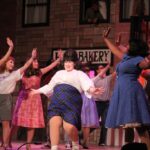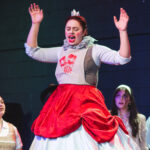Blood and destruction— because of one man. If that isn’t ever an accurate summation of today’s society compliments of Andrew Lloyd Webber… but if you strip away the myth from the man…what are you left with? A striking, and damn near award-winning production of Jesus Christ Superstar at The State Theater of Havre de Grace, that’s what. Directed by Austin Barnes with Musical Direction by Jarrett Rettman, and Choreography by Veronica Lane, this brilliantly nuanced and extremely meticulously plotted production is a staging for the ages; a ripe and raw exploration of the edgy rock concert that Andrew Lloyd Webber intended for the musical to be.
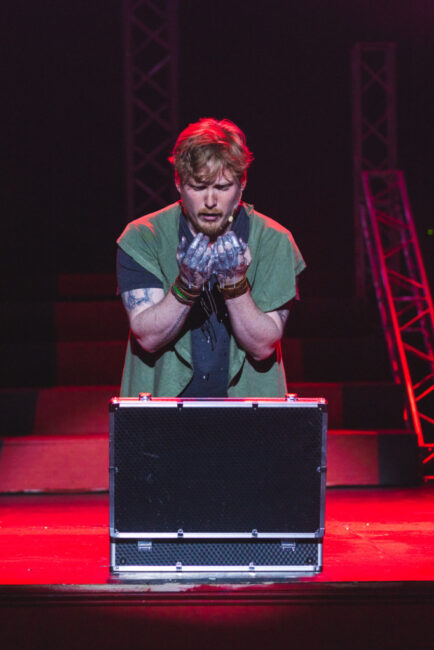
Let’s get the Easter Elephant out of the room; the show’s sound design was uneven. Nick Hankins & Jared Noe didn’t have the balance required on the space as a whole to make this a perfect production. Microphones popped in and out, feedback was a persistent issue, particularly coming on and off of solo moments with certain performers, and the band was overly loud throughout the entirety of the performance, despite being somewhat concealed in the show’s clever set. A lone, disappointing feature of the production in an otherwise striking, evocative, and inspiring theatrical experience.
Lighting, on the other hand, was thoroughly impressive. Designed by Patrick Yarrington, with the distressed 90’s adjacent grunge-abandoned-warehouse scenery in mind, the use of pulsating lights, colored fixtures, swirling gobos, house illumination, and atmospheric coloring elevated the aesthetic caliber of the production tenfold. Yarrington is a fan of lights pulsating and undulating with the beat of the music, this is particularly effective when Judas finds himself singing and plead-singing with the priests. A big fan of red for those more enraged moments, Yarrington does not shy away from utilizing oth soft and harsh blues to drive home the emotional effects of certain solo numbers. This is especially true for Jesus. And Judas. (Major shoutout to Mary McHugh on the follow-spot, as it is used frequently throughout the performance when characters are solo on the floor, creating a brilliant capture of them being the lone entity in focus.) The lighting of the show is intuitive, perceptive in a way that speaks to the overall vision of the director, one that enhances and assists rather than detracts or distracts from the theatrical experience as a whole. It’s very impressive and clearly well thought-out.
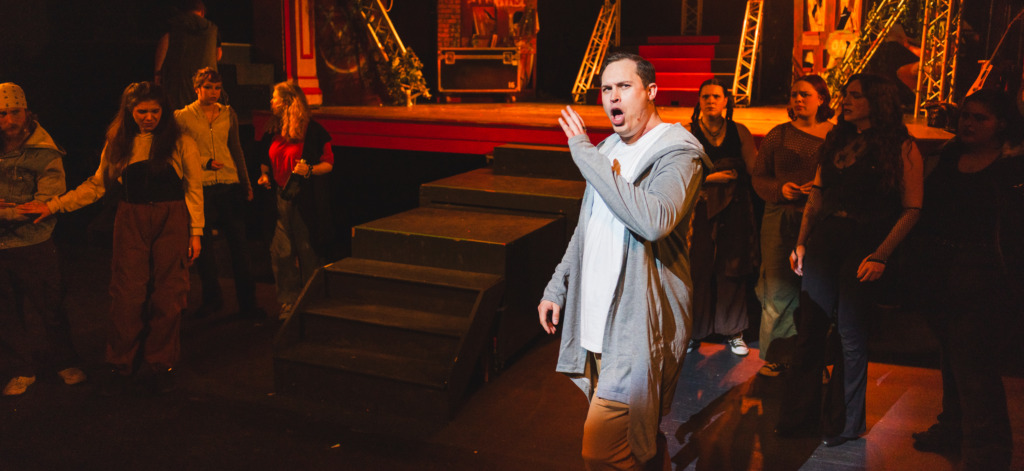
Everything about the production, from Jared Noe’s set design to the undisclosed costume designer’s sartorial selection, is clever and nuanced. The cast is very specifically adorned in grunge-gear that primes the brain to think 90’s— mesh and denim and drab, baggy garments in muddy earth tones. Backed against the distressed warehouse, built with graffiti panes and lighting-grid-rigging fixtures, one feels like Jesus is the coming revolution just before Y2K. (Except for that one moment where they all pull out their smart-phones, which actually almost reads with a meta “play-within-a-play” verve, where they’re doing a show set in the 90’s but real life hits and they have to soldier on despite devastating real-world news; it’s fascinating.) All the components of the show’s aesthetic exists with an intense sense of deliberacy; intentionally designed for maximum effect. The ensemble appear as the rabble— all covered in hoodies until Jesus pulls back their hoods to reveal them as his disciples. All of his disciples only ever wear trousers, whilst Mary Magdalene is the only character to wear a skirt and have her legs fully exposed (dancer girls in Herod’s Court and the Superstar Angels notwithstanding.) It’s exacting in detail, it’s deliberate in intention; the production’s aesthetic are superb, make sense, and make for an extraordinary experience on the whole.
Add to the astonishing aesthetic the detailed nuance with which Austin Barnes blocks the show, making full use of every inch of available space, playing with the levels— not only those built into and around the stage but the steps that lead down onto the house floor, and the spaces in the aisles of the audience. It’s remarkable and nothing short of theatrical genius. There are dozens of microscopic moments— blink and you’ll miss them— like when Pilate, appearing in so dark a shadow that you nearly do miss him, looms over the crucifixion at the end, watching for only an instant before growing disgusting and turning his back on the scene. Or the way Judas dips his hands into the suitcase full of ‘blood money’ coming up drenched in bloody silver; it’s shocking and gripping all at the same time. Choosing to stage the ensemble offstage during the outcry of “Crucify Him” where Pilate is at odds with himself so all you see is Pilate, the priests, and Jesus, but you hear the fullness of the cast without overcrowding the stage? It’s smart directing. It’s exceptional spatial awareness and it’s an excellent use of the structure of The State Theater of Havre de Grace as a whole.
The way Barnes transforms the disciples on the whole, using the simplicity of ‘hoods up/hoods down’ is really striking; it’s such an ordinary costume feature and yet speaks volumes on socio-political spectrum. During “The Arrest” you watch in small clusters as the desperate disciples, ready to throw-down on Jesus’ behalf, flip their hoods up to become enraged citizens of Caesar who wish death to Jesus. It’s so simple and yet executed so cleanly and so succinctly that it really makes a striking and lasting impact. Jesus strums his guitar solo on stage in live time and creates his own music for the solo “Gethsemane” and backed with murky teal lighting, it creates a powerful visual and vocal moment. One cannot say enough about Barnes’ spatial awareness and overall blocking and just the attention given to detail in every moving and working component of this production, particularly the dynamic relationships between characters, the way they are physically staged in relation to one another, and the overall use of the space as a whole; it’s innovative and truly refreshing.
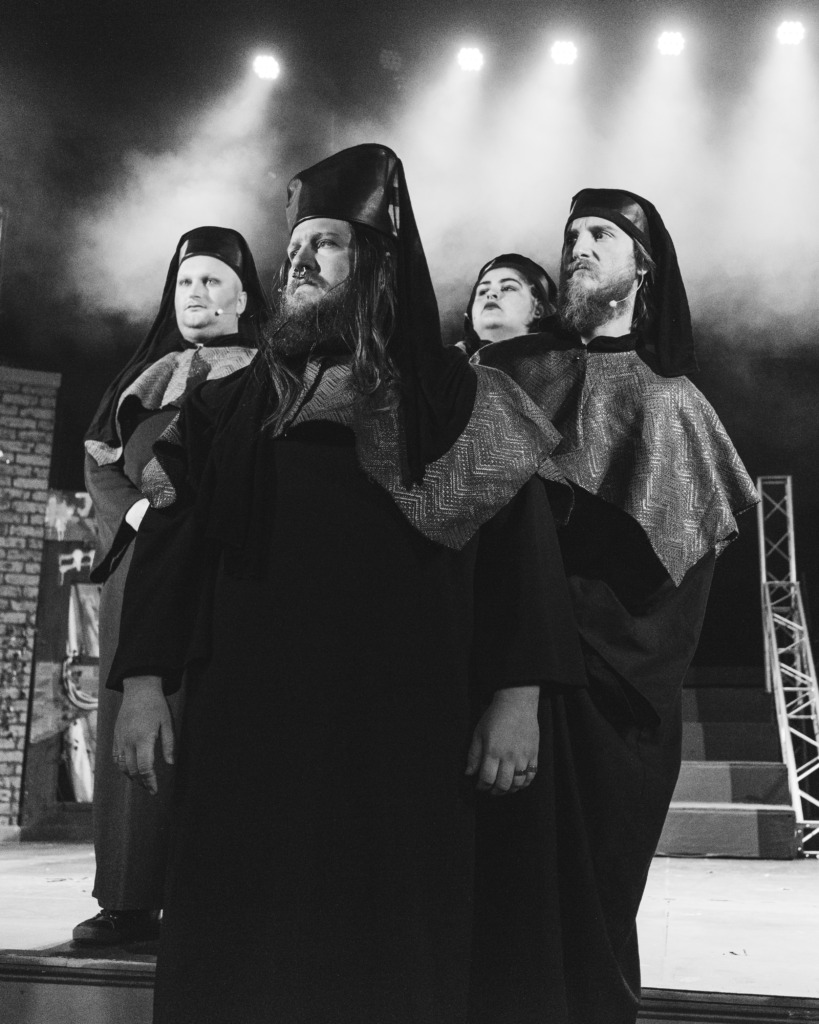
Musically, the pit (led by Jarrett Rettman on keys with Jamie Williams on guitar, Trey Pope on bass, and Joe Pipkin on drums) creates excellent sounds for the songs, even if they are overly loud. Buried in the set, with much of the action happening in front of them; you get spectacular flares of musical moments that really strike the ear. Lining this up with Veronica Lane’s intensely aggressive choreography and you’ve got a show for the ages. Lane’s choreography has an agitation to it, an aggravation that juts its way into each of the moves in her routines. Sharply staccato and jerky like broken cogs in a f**ked-up system, the moves feel jagged like spikes, not dissimilar to a crown of thorns, if you will, which is the perfect match for the aesthetic vibe of this production. Lane’s choreography is energetic and extremely intense, which makes it all the more impressive that it’s executed with such precision.
The ensemble (all named disciples, with two doubling up as priests) features Myles Turner, Jordan Burch, Kai Mellarkey, Rue Echegaray, Caitlin McLauchlin, Dawn Sinclair*, Brayden Piccolo-Klein, Miranda Holland, Rachel Bagley, Alana Guardipee, Shannon Lloyd-Ragan*, and Molly McVicker. Their voices are powerful and emotionally evocative. Whether chanting through the house “Hosanna” or thrusting their bodies in undulating waves during “The Temple” as they cry out for salvation, this ensemble is chock-a-block with talent. You get to hear Rachel Bagley and Alana Guardipee as ‘backing featured soloists’ during “Could We Start Again, Please?” a number that is reserved for Mary Magdalene and Peter but Bagley and Guardipee are sat on stage with their candles and provide backing echoes of the song’s title in a truly subdued but sublime fashion.
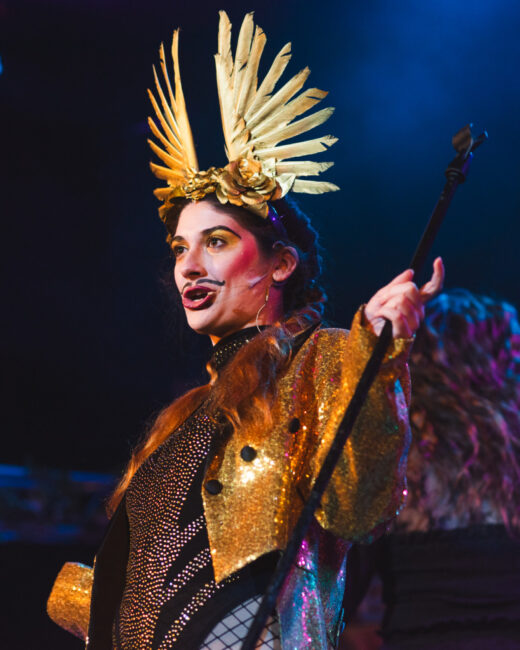
Kai Mellarkey, who plays the disciple Andrew, doubles up as King Herod and you get the feeling that she rolled in from The KitKat Club, channeling Sally Bowles— unhinged edition— and the Emcee into her performance as Herod. It’s unsettling to watch in a deeply fascinating vein and her costume defies description in the best way possible. Other notable standouts in the ensemble include the emotionally expressive Myles Taylor, playing Peter. Watching his facial features contort into fear and self-loathing when he’s accused of knowing Christ, which he ultimately denies, is it’s brand of emotional torture; it’s raw, relatable and real. And when his voice spins together with Mary Magdalene for “Could We Start Again, Please?” it’s devastatingly sweet. Jordan Burch also serves up a hot mess of attitude playing Simon Zealotes, though with the microphone issues it was difficult to hear her solo properly during her eponymous number.
Miranda Holland and Brayden Piccolo-Klein double up as priests (alongside the absent Shannon Lloyd-Ragan) lending their voices to the duo of pious players, Annas (Patrick Yarrington) and Caiaphas (Mondo Milliner) for numbers like “This Jesus Must Die” and “Blood Money.” Yarrington provides that escalated squeal-tenor sound in this moments which is the perfect juxtaposition up against the unearthly, almost demonic sound bass that rolls effortlessly out of Mondo Milliner’s Caiaphas. Seriously, Milliner’s voice sounds like it’s sludging its way up from the pits of Tartarus and it brings such an eerie and truly haunting edge to “This Jesus Must Die” that you feel instant goosebumps upon hearing it.
Bobby Sullivan takes up the role of Pontius Pilate with a practiced ease. Watching him stand alone at the center of the stage, staring down at a chess board, fiddling with the pieces as he sings “Pilate’s Dream” is an excellent nod to times gone by (#IYKYK) and it creates a level of introspection to the character that is often overlooked. Vocally Sullivan is superb, exceptionally well-suited for the role. Emotionally it’s intriguing to watch him shift from this slightly aloof political mastermind in his first number, to a man of put-upon airs and graces by the time he comes to “Pilate and Christ” morphing into this frightened figurehead whose hands are tied as the ensemble physically and vocally backs him into a ‘corner’ screaming to crucify Jesus. “Trial Before Pilate/39 Lashes”, which is brutal in its own right (not the least of which because of the glitter-bashing, rope-slashing chaos that Barnes choreographs into the number) is made that much more powerful by Sullivan’s voice. And when he ‘washes his hands’ of the whole affair, it’s a very unsettling moment.
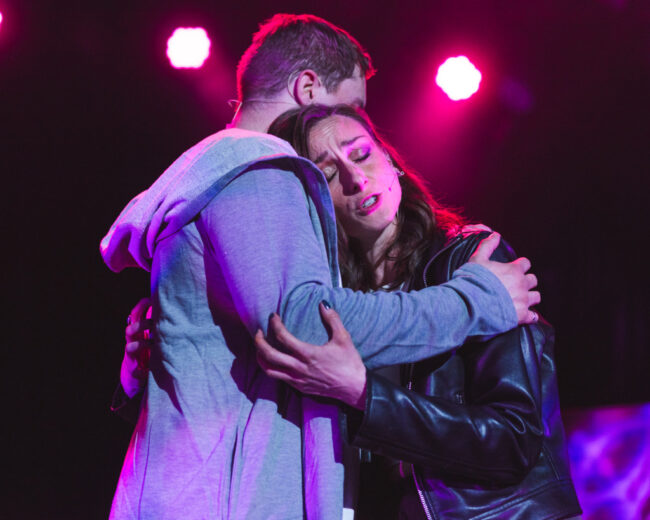
With slightly pop-modern vocals, which you think you would hate being layered over the Mary Magdalene track but because of the grungy-90’s verve permeating the whole experience it actually works really well, Katie Noe drops into “I Don’t Know How To Love Him” looking and sound a little like Alanis Morissette. And it actually gels really well with the production. Her interactions with Jesus are subtle; none of this ‘throwing herself around’ or sexing it up as is often the direction in which Mary Magdalene gets taken. There are even some really eye-catching moments, though they happen lightning quick, between Noe’s Mary and Judas Iscariot. It’s a unique take on the character, one that really serves the show well. Noe’s voice is beautiful and carries her solo moments sublimely.
It’s honestly a knock-down-drag-out tie as to who’s grabbing the audience’s attention more in this production— Jesus (Pat Collins) or Judas (Austin Barnes.) And the wild thing about it is that they aren’t fighting each other for top-billing; they’re fighting the narrative. The relationship built between Barnes and Collins is wondrous strange, truly congenial, and exists in the rawest sense of real time. It feels like you’re watching two brothers go at it for all the right and wrong reasons simultaneously and it’s brilliant. Barnes tells whole novels’ worth of emotions and feelings with singular looks and body language, nearly always addressed at Jesus and Collins has a similar approach to his facial expression. And it all just feels so authentic. Nothing showy or put-upon, all live and all visceral. Both are gifted vocalists, particularly when it comes to those screaming top-tenor vocal sounds that Andrew Lloyd Webber wrote into the score. And the grungy, gritty edge is there on both performers without ever compromising their vocal sound.

Barnes, as Judas, is thoroughly conflicted from jump-street. The anger is there but so too is the confusion. And the boy has got some riffs and options that are astronomically out of this world, particularly when he’s crying out at Caiaphas and the priests. While the visual setup of Jesus de-hooding the rabble to reveal disciples is the first thing you see, Barnes’ Judas is the first voice you hear and he sets the tone for the show with extraordinary grace and precision. No one can deny the extraordinary vocals that Barnes is bringing to the role but what’s even more fascinating to watch is his moments in silence because his facial expressions, which ripple down into his body language, are so intense. When the ensemble is parading about for “Hosanna” and Jesus is all caught-up in the throng, the “are you f**king serious right now” expression is holy and wholly unhinged. “Damned For All Time”, “Judas’ Death” and “Superstar” are three of his most expressive numbers and Barnes knocks it out of the park with that high-octane chaos that roles through the titular number.
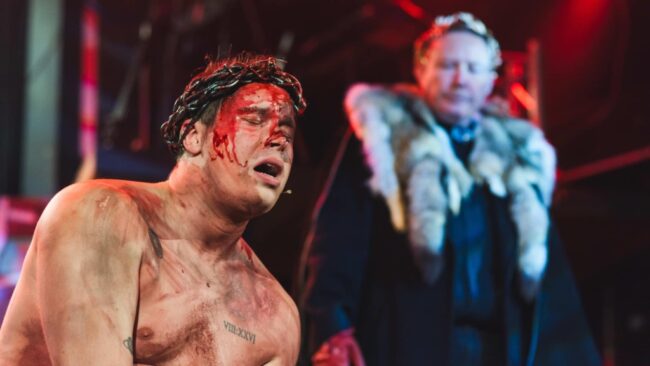
Collins, as the title superstar, is deeply expressive, and 90’s modern in a progressive “Kumbaya-but-modern-Jesus” way. He doesn’t present an arrogant Jesus, but rather a conflicted one, almost as if he and Barnes’ Judas share the same soul-splitting conflict only in different walks of life. He’s easily becalmed by Mary Magdalene, their working chemistry is more familial and platonic and it creates for beautiful sentiment and imagery. Collins has a stunning voice, “Poor Jerusalem” and “Gethsemane” are mellifluous and emotionally dense when he sings them. And much like Barnes, its Collins’ reactions that really engage the audience. Watching him stumble, tumble, and flail about after “39 Lashes” is one of the most fascinating experiences (and I’ve seen Jesus Christ Superstar easily a dozen times or more on professional and community stages alike) for this show. Judas is up there belting his face off doing the holy roller number while Collins’ is desperately struggling with the crossbar lighting rig that becomes his own cross to bear. It’s astonishing beyond words.
What is truth? We both have truths; are yours the same as mine? Mine is that this is the best production to appear on a stage in Havre de Grace in quite some time, and sound disasters notwithstanding, it’s a perfect and stunning production of Jesus Christ Superstar that shouldn’t be missed! They’re running through Easter weekend and you won’t want to miss this theatrical miracle.
Running Time: Approximately 1 hour and 50 minutes with one intermission
Jesus Christ Superstar plays through April 20th 2025 (yes, they play on Easter Sunday and those tickets are moving QUICK!) at The State Theater of Havre de Grace— 325 St. John Street in historic downtown Havre de Grace, MD. Tickets are available at the door or in advance online.
*indicates performers who were absent from the final dress performance due to illness.


